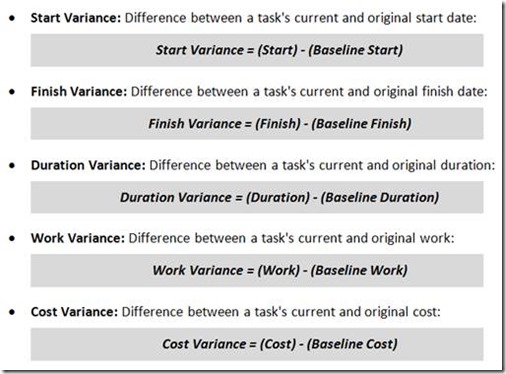A Baseline is essentially a snapshot of your project schedule, it should be captured once your schedule is complete and you’re ready to begin your project. The moment your project starts events will occur that you didn’t account for in your project schedule e.g. a resource that was assigned to a task, started later than initially planned. This ‘slippage’ in your schedule will have detrimental effects to your project; especially if the project is on the Critical Path. In Microsoft Project we have the ability to set a baseline for our project. In fact; In Microsoft Project, we have the ability to set up to 11 baselines. Having a baseline really helps a project manager to see at the following at any time. · Baseline Durations for Tasks · Baseline Start Dates for Tasks · Baseline Finish Dates for Tasks · The Baseline work for Tasks · Baseline Cost for Tasks Schedules are constantly updated and change over time once information is gathered from the project team. However, the Baseline will never change. This allows us to compare, for example; the current scheduled start date for a task to its Baseline Start date. Likewise, we can compare scheduled finish to Baseline Finish, ‘Scheduled Work’ to ‘Baseline Work’, ‘Scheduled Cost’ to ‘Baseline Cost’ etc. So what actually happens when we set a Baseline in Microsoft Project? Select the ‘Baseline Table’ in Microsoft Project. From the ‘Data’ section of the View ribbon click on the ‘Tables’ dropdown and select ‘More Tables’
Select the ‘Baseline’ Table and click ‘Apply’.
You can see at present the ‘Baseline Duration’ is 0 Days, the ‘Baseline Start’ and ‘Baseline Finish’ display ‘NA’, ‘Baseline Work’ displays ‘0 hrs’ and ‘Baseline Cost’ displays ‘$0.00’. This is because at present there is no baseline.
To set a Baseline; from the ‘Schedule’ section of the ‘Project’ ribbon click on the ‘Set Baseline’ dropdown menu and click ‘Set Baseline’
From the ‘Set Baseline’ dialogue we can select a Baseline. We can see in the ‘Set baseline’ dropdown menu the 11 available Baselines that we can select. However the Baseline that drives the variances and report by default is what we describe as ‘Baseline 0’ which is just ‘Baseline’. (It’s commonly called ‘Baseline 0’ in the industry to differentiate it from other Baselines). With Baseline selected (it’s the default) we can click ‘OK’. Baseline 0 is now set.
If we look back at the ‘Baseline’ table we can now see that all the fields have been populated. Essentially for each task: the ‘Duration’ has been copied into the ‘Baseline Duration’, the ‘Start’ has been copied into the ‘Baseline Start’, the ‘Finish’ has been copied into the ‘Baseline Finish, the ‘Work’ has been copied into the ‘Baseline Work’ and the ‘Cost’ has been copied into the ‘Baseline’ Cost.
To visualize the ‘Baseline’ on the Gantt Chart; from the ‘Bar Styles’ section of the ‘Format’ ribbon click on the ‘Baseline’ dropdown and select ‘Baseline’. You will then see a grey bar side by side with your blue bar. The grey bar represents the ‘Baseline’; the blue bar represents the current schedule.
I am now going to update the schedule. For example; the resource assigned to the task informs me that the task will now take 7 days as opposed to 5 and he started the task on Monday 3/31 as opposed to Friday 3/28. The changes are reflected on the Gantt chart, the task is pushed out but the Baseline stays the same.
If you review the ‘Variance’ table you can now see these changes reflected.
Project variances measure the difference between the current schedule and the baseline. In other words, project variances tell where the project has deviated from the original plan before the project started.
There are five types of variances that you can analyze in a project schedule:
Negative variances indicate where the project is performing better than the original plan, and positive variances indicate where the project is performing worse than the original schedule. Being able to make these comparisons is an essential part of scheduling. Capturing a baseline allows a user to compare back to what they initially thought would happen and how much the activities would cost. It also enables a Project Manager to see where a project deviated and perhaps learn from what happened.

![clip_image002[8] clip_image002[8]](https://blog.epmainc.com/wp-content/uploads/clip_image0028_thumb.jpg)
![clip_image004[8] clip_image004[8]](https://blog.epmainc.com/wp-content/uploads/clip_image0048_thumb.jpg)
![clip_image006[8] clip_image006[8]](https://blog.epmainc.com/wp-content/uploads/clip_image0068_thumb.jpg)
![clip_image008[8] clip_image008[8]](https://blog.epmainc.com/wp-content/uploads/clip_image0088_thumb.jpg)
![clip_image010[8] clip_image010[8]](https://blog.epmainc.com/wp-content/uploads/clip_image0108_thumb_56ce0d8e7817e.jpg)
![clip_image012[8] clip_image012[8]](https://blog.epmainc.com/wp-content/uploads/clip_image0128_thumb.jpg)
![clip_image014[8] clip_image014[8]](https://blog.epmainc.com/wp-content/uploads/clip_image0148_thumb.jpg)
![clip_image016[8] clip_image016[8]](https://blog.epmainc.com/wp-content/uploads/clip_image0168_thumb.jpg)
![clip_image018[8] clip_image018[8]](https://blog.epmainc.com/wp-content/uploads/clip_image0188_thumb.jpg)


